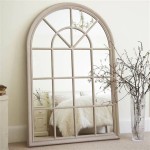Hanging a Vanity Mirror with Command Strips: A Comprehensive Guide
Hanging a vanity mirror is a common task for homeowners and renters alike. Mirrors enhance the aesthetic appeal of a bathroom or dressing area, create the illusion of more space, and, of course, serve their primary function of reflection. Traditionally, mirrors are mounted using screws, nails, or other hardware that requires drilling into the wall. However, this method can be problematic, especially for those living in rental properties or those hesitant to damage their walls. A popular alternative is using Command Strips, adhesive strips designed to hold items securely without causing damage upon removal. While Command Strips offer a convenient solution, it's crucial to understand their capabilities, limitations, and proper application techniques to ensure the mirror is safely and securely mounted.
This article provides a comprehensive guide to hanging a vanity mirror using Command Strips. It covers essential considerations, step-by-step instructions, troubleshooting tips, and alternatives to ensure a successful and damage-free mirror installation. The aim is to equip individuals with the knowledge necessary to confidently and effectively utilize Command Strips for this specific application.
Key Considerations Before Hanging Your Mirror
Before even considering the application process, several factors must be taken into account. Failing to address these preliminary considerations can lead to the mirror falling, damaging the mirror itself, the wall, or even causing injury. The weight of the mirror, the type of Command Strips used, the surface to which the strips will be applied, and the existing environmental conditions all play a critical role.
Mirror Weight: The weight of the vanity mirror is arguably the most important factor. Command Strips are designed with specific weight limits. Exceeding this limit significantly increases the risk of the mirror falling. Always check the product packaging to determine the maximum weight each strip can hold. It's generally recommended to use more strips than the minimum required, especially for heavier mirrors, providing a greater margin of safety. Calculate the total weight of the mirror accurately; if unsure, it's best to overestimate. A bathroom scale can be helpful for determining the precise weight.
Command Strip Type: Command Strips come in various types, each with different weight capacities and intended uses. For mounting a heavy object like a vanity mirror, it's essential to select strips specifically designed for heavy-duty use. Look for Command Strips labeled as "Heavyweight" or "Picture Hanging Strips," ensuring they are appropriate for the mirror's weight. Furthermore, consider the environment. If the bathroom is prone to high humidity, opt for Command Strips specifically designed for bathroom environments, as these are more resistant to moisture and less likely to fail due to humidity.
Surface Type: The type of wall surface significantly impacts the effectiveness of Command Strips. Smooth, non-porous surfaces like painted drywall, tile, and glass are generally ideal. Avoid applying Command Strips to textured walls, wallpaper, or peeling paint, as the adhesive may not adhere properly to these surfaces. If the wall is freshly painted, allow the paint to cure completely (typically several days to a week) before applying the strips. This ensures the paint has fully hardened and won't be damaged during removal. Cleaning the surface thoroughly before application is crucial, as dust, dirt, or grease can compromise the adhesive bond.
Environmental Conditions: As mentioned earlier, humidity can affect the performance of Command Strips, especially in bathrooms. Extreme temperatures can also weaken the adhesive. Ensure the bathroom is adequately ventilated to minimize humidity levels. It's generally recommended to avoid using Command Strips in areas that experience extreme temperature fluctuations. If the bathroom is frequently subjected to steam, consider alternative mounting methods that are more resistant to moisture.
Step-by-Step Instructions for Hanging a Vanity Mirror with Command Strips
Once the preliminary considerations have been addressed, the following steps provide a detailed guide to hanging the vanity mirror using Command Strips. Following these instructions carefully will maximize the chances of a successful and secure installation.
Gather Materials: Before starting, gather all the necessary materials. These include: * Vanity mirror * Command Strips (appropriate for the mirror's weight and bathroom environment) * Level * Measuring tape * Pencil * Clean cloth * Rubbing alcohol
Prepare the Wall Surface: Thoroughly clean the wall surface where the mirror will be hung. Use a clean cloth dampened with rubbing alcohol to remove any dust, dirt, grease, or other contaminants. Allow the surface to dry completely before proceeding. This step is crucial for ensuring a strong adhesive bond.
Prepare the Mirror: Clean the back of the vanity mirror where the Command Strips will be applied. Use a clean cloth dampened with rubbing alcohol to remove any dust or residue. Allow the surface to dry completely. This ensures the strips adhere properly to the mirror.
Attach Command Strips to the Mirror: Follow the instructions on the Command Strip packaging carefully. Typically, this involves separating the strips and pressing them firmly onto the back of the mirror. Distribute the strips evenly across the back of the mirror, paying particular attention to the top corners and along the bottom edge, as these areas will bear the most weight. Ensure each strip is securely attached to the mirror.
Position the Mirror on the Wall: Use a measuring tape and pencil to mark the desired location for the mirror on the wall. Use a level to ensure the mark is straight. Carefully align the mirror with the marked location on the wall. This step requires precision to ensure the mirror is hung straight and at the desired height.
Press the Mirror Firmly Against the Wall: Once the mirror is aligned with the marked location, press it firmly against the wall for the recommended time specified on the Command Strip packaging (typically 30 seconds to 1 minute). This ensures the adhesive forms a strong bond with the wall surface. Apply even pressure across the entire mirror to ensure all the strips are making good contact.
Remove the Mirror and Press Strips (If Applicable): Some Command Strip instructions advise removing the mirror after initial adhesion to the wall to allow the adhesive to strengthen. If your specific Command Strips require this, carefully detach the mirror from the wall, leaving the strips attached to the wall. Press each strip firmly against the wall for the recommended time to further strengthen the bond. Then, wait the recommended time (often an hour) before re-hanging the mirror.
Hang the Mirror: After the waiting period (if applicable), carefully re-hang the mirror onto the strips that are now attached to the wall. Ensure the mirror is properly aligned and securely attached. Press the mirror firmly against the wall again to ensure a secure bond. Double-check the level to ensure the mirror is hanging straight.
Troubleshooting and Alternatives
Despite diligent preparation and adherence to the instructions, issues can still arise. This section addresses common problems and provides alternative solutions for hanging a vanity mirror.
Mirror Falling: If the mirror falls, immediately identify the cause. Was the weight limit exceeded? Was the surface not properly prepared? Were the wrong type of Command Strips used? Replace the damaged Command Strips with new ones, ensuring the correct type and weight capacity are used. Thoroughly clean both the mirror and the wall surface before re-applying the strips. If the mirror continues to fall, consider alternative mounting methods.
Command Strips Failing to Adhere: If the Command Strips are not adhering to the wall or the mirror, ensure both surfaces are clean and dry. Try using a stronger adhesive, such as Command Strips specifically designed for challenging surfaces. If the problem persists, the wall surface may be unsuitable for Command Strips. Consider alternative mounting options.
Alternatives to Command Strips: If Command Strips prove ineffective or unsuitable, several alternative mounting methods can be considered. These include: * Adhesive Mirror Glue: Mirror glue is a strong adhesive specifically designed for mounting mirrors. It provides a more permanent bond than Command Strips. However, it can be difficult to remove and may damage the wall. * Screws and Anchors: This is the most secure method for mounting a heavy vanity mirror. However, it requires drilling into the wall and may not be suitable for rental properties. * Mirror Mounting Clips: These clips are designed to hold the mirror in place and can be attached to the wall using screws or adhesive. They provide a more secure mounting solution than Command Strips while minimizing damage to the wall. * Leaning Mirror: Using a large, free-standing leaning mirror eliminates the need for wall mounting entirely. This is a simple and damage-free solution, especially for renters.
Ultimately, the choice of mounting method depends on the weight of the mirror, the type of wall surface, and the individual's preference for permanence and potential wall damage. Careful consideration of these factors will help ensure a safe and successful vanity mirror installation.

Using Command Strips For Hanging A Mirror The Morris Mansion

How To Make An Easy Diy Bathroom Mirror Frame Momhomeguide Com

Using Command Strips For Hanging A Mirror The Morris Mansion

Can You Hang A Mirror With Command Strips Hanging Heavy Round Bathroom

Diy Mirror Easy Upgrade Shanty 2 Chic

Command Mirror Organizer Quartz 3m United States

Using Command Strips For Hanging A Mirror The Morris Mansion

Command Mirror Organizer Quartz 3m United States

How To Make An Easy Diy Bathroom Mirror Frame Momhomeguide Com

Using Command Strips For Hanging A Mirror The Morris Mansion







